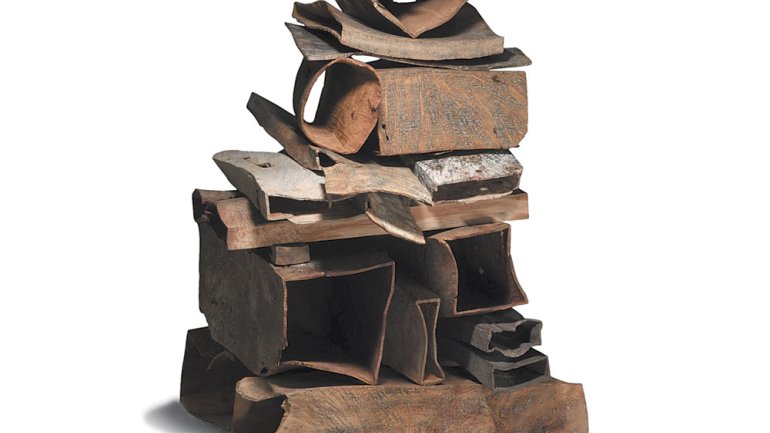Landscapes in the Grain
Landscapes in the Grain
Bellevue Arts Museum
Michael Peterson: Evolution/Revolution
Bellevue, Washington
April 9 – September 20, 2009
bellevuearts.org
The Northwest artist Michael Peterson has shifted over the past 20 years from a masterful maker of turned wood bowls into a sculptor of organic abstract works whose complex forms and textured surfaces are achieved through a variety of processes without the use of the lathe. This exhibition demonstrates Peterson’s progression from turner to carver to sculptor through more than 30 works—some 15 vessel forms shown alongside more than 20 of his most recent sculptures.
Peterson’s chosen material is the burl portion of trees—dome-shaped outgrowths of madrone, maple, elm, locust and others—that he is drawn to for their organic form as well as their density and unique grain patterns. He harvests this idiosyncratic material from downed timber he finds near his home on Lopez Island in Washington State. The Texas-born artist settled in the Northwest in the 1970s, lured by the physical environment, especially the native woods.
In his quest to explore the qualities of these woods, Peterson developed techniques such as bleaching, sand- blasting and pigmenting to transform the material to evoke landscapes. One sees this in the surfaces of turned works like Taos, 1989, or Landscape series, 1989 . “I think what was happening was that my techniques were becoming aligned or in accord with the natural processes of nature, such as the effects of wind and water, sand and sun, all working away on surfaces and forms,” says Peterson, in an interview with Michael Monroe, the show’s co-curator, published in the catalog.
Gradually abandoning the lathe for the chainsaw and carving tools, Peterson shaped or hollowed out chunks of wood, often working it in its wet, green state. He created groupings, generally paired forms, which sometimes resembled birds, stones and other natural elements. In his most recent pieces, for example, Coastal Stacks VI, he goes vertical, building multiple hollowed out boxlike units into asymmetrical arrangements that suggest wave- tossed driftwood on a beach. Where the earlier turned pieces contained landscapes, these works seem to be landscapes in themselves, the effect enhanced by Peterson’s rich use of color.
Though the latest works seem radically different from the early vessels—the “revolution” implied by the show’s title—the continuity of Peterson’s oeuvre is apparent, not only in the persistent landscape theme but also in the realization, as one observes these forms and textures—no two alike—that this is work that grows out of its making, following its own logic, rather than any predetermined plan. As Peterson says, quoted by Kevin Wallace, “When starting a piece it’s not always best to know where it’s headed. Rather than thinking my way through a piece, it’s more like feeling my way through it. I’m drawn to a process that allows the material to reveal itself, and favor one that allows me to become as lost in the process as possible.”
The catalog, with essays by Michael Monroe, Robyn Horn, Matthew Kangas and Kevin Wallace, is $45.

